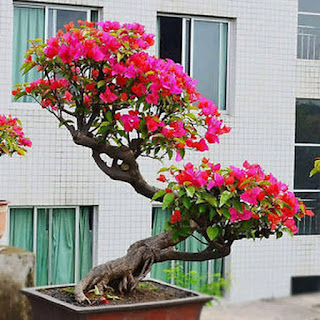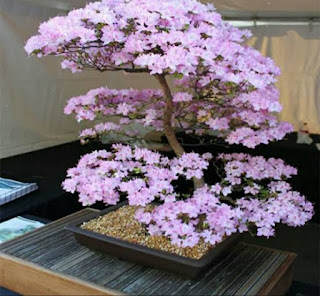Bonsai Trees : Top 5 Guidances to Know About This Beautiful Art Plants
🦋 About Bonsai Trees :
Bonsai (盆栽) is a plant or tree that is stunted in a shallow pot with the aim of making a miniature of the original form of a large tree that is old in the wild. Planting (sai, ) is done in shallow pots called bon (盆). The term bonsai is also used for traditional Japanese art in the maintenance of plants or trees in shallow pots, and appreciation of the beauty of the shape of the branches, leaves, trunks, and roots of trees, as well as shallow pots that become containers, or the overall shape of a plant or tree. Bonsai is the Japanese pronunciation for penzai (盆栽).
This art includes various techniques of cutting and pruning plants, wiring (forming branches and branches of trees by wrapping wires or bending them with wire ties), and making roots spread over rocks. Making bonsai takes a long time and involves a variety of jobs, including fertilizer application, pruning, plant shaping, watering, and replacing pots and soil. Plants or trees are stunted by cutting the roots and branches. Trees are formed with the help of wires on the branches and shoots. The wire must be removed before it can scratch the bark of the tree branch. Plants are living things, and no bonsai can be said to be finished or finished. Changes that occur continuously in plants according to the season or natural conditions are one of the attractions of bonsai.
🦋 5 Guidances for Beginners to Make This Bonsai As a Beautiful Art Plants :
A. The first step you have to do is choose plant seeds for bonsai. You can get this bonsai from nature or from propagation. Propagation results refer to seeds in the form of seeds, stem cuttings, grafts, grafting, and grafts. Whatever the form of the seed, the selected plant must meet the following criteria: Derived from dicot plants; The plants have a long life; Has high durability in various conditions; The shape is naturally beautiful; and Can withstand detraining. For the record, you can turn some monocot plants into bonsai. For example, coconut seeds, bamboo, shrubs, and shrubs.
B. Choosing the Right Planting Media :
Bonsai soil containers are usually thin and small pots, therefore the growing medium and supply of plant nutrients are limited. Therefore, you must choose a planting medium that contains high nutrients and mineral ingredients. The goal is that plants can grow well even though the growth space is limited. The choice of planting media itself consists of sand, mountain soil, and red soil. The goal is that plants can grow well even though the growth space is limited. The choice of planting media itself consists of sand, mountain soil, and red soil. Then add humus, compost, and manure to meet the nutritional needs of the bonsai.
C. Best Pots for Planting Bonsai :
For pots, you should use a tray that has a drainage hole. Then fill the pot with four layers of planting medium, in the following order: Water-resistant stone at the bottom of the pot A mixture of soil and small rocks in the next layer Layers of soft soil or sand to facilitate the flow of water out of the pot Soil is loose, full of humus, and fertile up to 35 cm thick at the top of the pot.
D. Planting and Maintenance :
The next step is to plant the bonsai in the plant pot. Simply plug the willow stem in the center of the pot, then water it using a fine sprayer. Make sure the water you use is clean, not muddy, and neutral (fresh), ok. If water starts to run out from under the pot, stop watering and store the pot in a shady location. In order for the seeds to grow faster, you can cover the plant using transparent plastic during the early stages of growth.
E. Taking Care and Formation of Bonsai Art Plants :
Bonsai that are ready to be formed are those whose roots have not been shaken. You can use brass wire and raffia rope to adjust the direction of growth. The concept is more or less the same as when you herd the growth of vines. It's just that the pressure given must be a little stronger because the stems of the plant tend to be hard. In addition, you have to prune and pluck unwanted growing points. The trick, cut the branch or twig as close as possible to the healthy-looking flower and cover the large wound with paraffin. Then wrap the elongated branches with wire during new growth. But remember, forming this plant takes a long time so you have to be really patient.
🦋 5 Types of Bonsai Art Plants for Home Decoration :
1. Bonsai Bougenville:
The appeal of the bougainvillea plant is in its flowers and leaves. The color of this paper flower plant varies, ranging from white, pink, yellow, purple, to magenta. Bougenville plant type glabra purplish pink. The characteristics of the flowers on this bougenville are thin but wide. Because it has a variety of beautiful color choices, bougainvillea bonsai are in great demand for decoration in homes and offices.
2. Banyan Bonsai:
Banyan is a plant that is synonymous with large and lush. Because of its large size, banyan is rarely planted in the yard of the house. With the bonsai technique, you can put a dwarf banyan in the house. The shape of a sturdy tree with lush leaves makes the banyan bonsai become its own attraction for bonsai collectors.
3. Fir Bonsai:
This leafy shrub tree can grow in the wild up to tens of meters. With the bonsai technique, you can bring the natural feel of the fir tree into your home. The type of fir plant that is often chosen for bonsai is the sinesis pine with an eccentric stem bend. This type of fir is not only for collection, but also exhibited in contests.
4. Grape Bonsai:
The vine is a vine that is quite difficult to bonsai. However, displaying the bonsai character of the vine together with the fruit is a challenge for bonsai enthusiasts. The vine naturally likes hot climates and high sunshine. These properties make the vine match the bonsai character.
5. Sakura Bonsai:
Bonsai sakura is one type of bonsai plant for the home that is much-loved by the public. This Japanese plant can be presented at home with the bonsai technique. The beauty of the sakura bonsai lies in the soft color of the flowers. When the flowers bloom together, it will make the sakura bonsai plant more beautiful.
🦋 7 Most Expensive Bonsai Plants in the World :
1. Bonsai Sargent Juniper:
This bonsai is the work of a bonsai artist named Masahiko Kimura. According to information, the age of this special tree has reached 250 years. The Sargent Juniper Bonsai made by artist Kimura is estimated at around US$ 350 thousand.
2. Pine Bonsai :
One of the most expensive bonsai plants is the pine bonsai. The high price of pine bonsai is due to its centuries-old age. Quoted from Bonsai Tonight, the price of pine bonsai ranges from US $ 50 to US $ 1.3 million. Unlike other types of bonsai, pine bonsai is one type of bonsai that is not suitable for beginners. Because, this bonsai is the most difficult to understand, arrange, and pruned due to factors such as climate.
Kimeng bonsai plants are believed to be able to shed prolonged stress and saturation. Caring for these ornamental plants at home will make life feel more peaceful and happy. Who would have thought, this plant has a price that tends to be expensive because it has a unique and adorable shape. If it is cared for very well and shaped it uniquely, then the selling value will be higher from time to time. In fact, there is a kimeng bonsai that sells for up to $10,000. Even though it is expensive, it doesn't seem to discourage plant collectors from buying and caring for this plant.
4. Old Pine Bonsai Tree:
Bonsai's fame actually came years ago, but the unique shape and ease of care of this tiny tree still make it a favorite plant for plant collectors. The most expensive price for this bonsai is 100 million yen, or the equivalent of $13,000 for a type of white pine sold at an Asia Pacific bonsai exhibition in Takamatsu, Japan.
5. Bonsai Ficus Misrocarpa:
In 2018, at the Bonsai Festival, a bonsai that was estimated to be over 100 years old was exhibited. Bonsai originating from Taiwan belongs to a collector. The type of plant is Ficus microcarpa. The Ficus microcarpa tree is classified as large and grows a lot in the highlands. The price alone came to $100,000. The price is not without reason, because the trunk on a large bonsai tree and its roots are obtained in decades.
The first most expensive bonsai in the world is the Shunkaen bonsai owned by bonsai artist, Kunio Kobayashi. Named Shunkaen bonsai because this bonsai comes from the city of Shunkaen which is not far from Tokyo, Japan. The age of this bonsai is about 800 years, so it is not surprising that this plant has been named the most expensive bonsai in the world. The price of this plant was offered at US$ 90,000.
7. Bonsai Chinese Hackberry:
The next most expensive type of bonsai tree is the Chinese Hackberry. Besides being expensive, it is mentioned that this bonsai is also one of the oldest. He is more than 65 years old. In shape, Chinese Hackberry has a height of about 20 inches or about 50 cm. Hackberry (Celtic) itself is a tree with a fine twig structure. In spring, this tree will flower in spring and bear fruit in early summer. The price of this bonsai is priced from hundreds of millions of dollars to billions of dollars.
🦋🦋 Hopefully this bonsai trees flyer is usefull as always so could be known well about these beautiful art plants 🥳.
🦋❤🦋



.jpeg)




-min.jpeg)



-min.jpeg)


0 Response to "Bonsai Trees : Top 5 Guidances to Know About This Beautiful Art Plants"
Post a Comment